 | |||
 |
 |
 | |
 |
 | ||
 |
 | ||
 |  | ||
 |  | ||
 | |||
 |
 |
 | |
 |
 | ||
 |
 | ||
 |  | ||
 |  | ||
| Written by Paul D. Race for Family Garden Trains(tm)
and New Boston and Donnels Creek: |
 |
|
|
Framing the NEW New Boston and Donnels Creek RR, Part. 3If you've been following along with our planning, groundbreaking, and framing articles, you know that we moved in November, 2016 and have been planning and working on the new iteration of our railroad since March, 2017. The new version will be entirely raised, some of it quite high for vertical interest. All of it will be set on lumber, not on dirt, to avoid the problems of constant weeding and burrowing animals we experienced with our first railroad.This is, obviously a followup to our "Framing the NEW New Boston and Donnels Creek RR, Part. 2" article, in which I tweaked the design for highest level on which trains will be running and began framing it out. Where Things Stood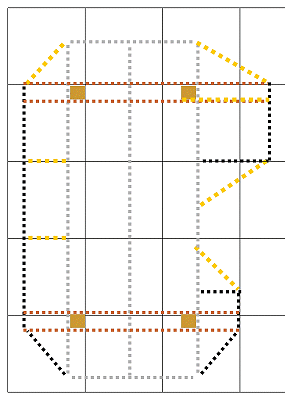 The graphic to the right shows the parts added since the last article in black and the parts remaining at the beginning of this article in amber. (The gray dotted lines show the parts that were there already and stayed there.) The graphic to the right shows the parts added since the last article in black and the parts remaining at the beginning of this article in amber. (The gray dotted lines show the parts that were there already and stayed there.)
One concern was that I wanted the far end of the notch for the waterfall (shown in the upper right of the graphic) to jut out further than the near end. That meant moving things around to provide more support out there. First, I moved one of the crosspieces I had installed to the other end of the railroad, screwing it to the other side of the post from the crosspiece that was already there. That's represented by the black dotted line running parallel to the reddish-brown dotted line near the bottom of the graphic. Then I cut two longer crosspieces and installed them at the other end. Those are represented by the two black dotted lines running parallel near the top of the graphic. Then I toenailed the long frame board on the left (shown in black) into the four cross-pieces that are supporting the framework (shown in reddish-brown). Then I added the diagonal trim piece on one end. It was surprisingly stable. If I just added a diagonal cross-piece on the other end (shown in amber), I'm sure it would have held long and well. However, I though I would add a short bit (shown in amber) attached between the two outside frame boards just to provide more support for the decking that will go there. The L-shaped black bits to the right are part of the "notch" where the waterfall will hopefully start. I toenailed the boards that cross both of the crosspieces into place. Then I installed the little boards that jut out from the long frame piece.
I have been researching what the decking will be since April, and I kept coming back to pressure-treated 2"x6". Both Lowes and Home Depot offer 1/2" ground-rated plywood that should work and be cheaper, but there are a lot of reviews from people claiming that the plywood delaminated the first time it got wet. Considering that I hope this installation stays maintenance-free, such reports were hardly encouraging. I decided to see how many scrap pieces of 2"x6" I had when the framing was finished and determine how much more going with a proven solution was going to cost me. That discussion is below. Ordering More MaterialsSince the water feature was going to be an integral part of the layers I was building, I started picking up the pieces I would need for this year's installation. I also picked up some recycled sheet vinyl to line the oversized "planters" I was building.Vinyl Underlayment - Even though the 2"x6" lumber I'm using is "ground rated," I want to put a vinyl liner between the dirt and the lumber. I priced pond and roofing material, but that was going to cost "real money."
I ordered a 12'x18' piece that was supposedly 15-17 mil (many of them are ~11 mil). That will be enough to cover the "tabletops" I'm building this year and have some leftover to evaluate its usefulness as a pond or "river" liner if I ever choose to go that way. Counting shipping it was about 19 cents a square foot, or 2/5 the cost of most roofing or pond lining material.
Pond Pump - Here's a conundrum - I plan eventually to have a waterfall that is nearly five foot tall. And pond pumps that drive a strong flow of water 5' above the pump's level are not cheap. Yes, you can buy a pump that is rated at 1200 gallons per hour (a respectible waterfall flow) for under $100. But those ratings are made with the pump actually not pushing the water uphill at all. The amount of flow goes down with every inch of vertical rise, so that many "1200gph" pumps barely deliver a trickle if you go up five feet. I would like to have a pond eventually, but in the meantime, I decided I'd get a pump that will supply my needs between now and then, raising water may be three feet in the air. Water Spillway/Weir - I had planned to put a biological water filter at the top of the waterfall, and I still may. But the way things have moved around, I've decided that having my main filter up there could be a pain. Also, I won't have an actual pond installed this year, so I figure I'll let the little filter on the pump do the work for now. I did buy a little box with a spillway that I planned to put at the very top of the waterfall. It is shaped like a biofilter, and I suppose I could put some of those little wiffleballs or some water hyacinths in it next year. But for now, it's just a way to get the waterfall started.
After a couple dry evenings and part of one Saturday morning, I finally have the top layer framed out (shown in amber). I made a couple very minor changes, so I'm republishing the plan one more time. I've redrawn the revised shape of the loop as carefully as I could, to give an idea of where I think it will come. I'm planning on using 5'-diameter curves for the most part. Eventually, this train will be all "shorties," ore cars or the like, while the next railroad down will probably be based on 8' curves and allow longer pieces to look right. The final, lower layer, if and when it comes, will be based on 10' and larger curves and allow me to run my heavyweight coaches and other big pieces.
|
 |
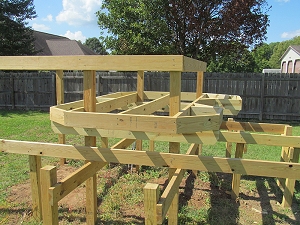 |
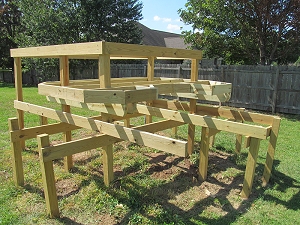 |
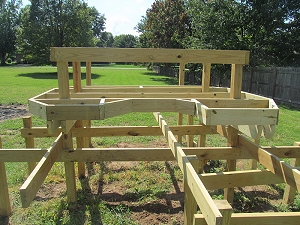 |
 |
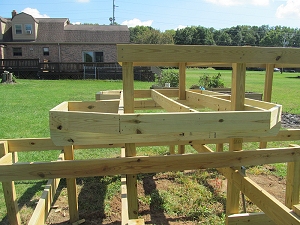 |
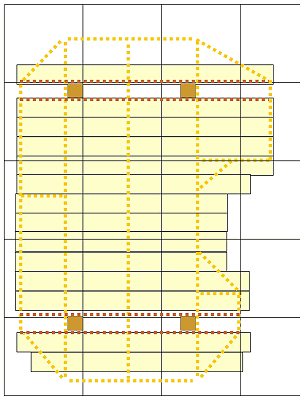 While trying to figure out if I wanted to go with ground-rated 2x6s for the decking, I drew the graphic to the right to determine how many boards I'd need. About seven if I figured it right. Maybe eight at the most. Then I figured out how many sheets of ground-rated plywood I'd need if I really cheaped out and used the half-inch stuff with all the complaints. Turns out that installing a relatively bullet-proof decking would only cost 20-30% more than cheaping out.
While trying to figure out if I wanted to go with ground-rated 2x6s for the decking, I drew the graphic to the right to determine how many boards I'd need. About seven if I figured it right. Maybe eight at the most. Then I figured out how many sheets of ground-rated plywood I'd need if I really cheaped out and used the half-inch stuff with all the complaints. Turns out that installing a relatively bullet-proof decking would only cost 20-30% more than cheaping out.
Duh.
Eventually, I would like to put row of 2x6s underneath the ROW on this level, but for now, I think I'll just lay out my black vinyl, poke holes in it for drainage, put some sort of lip around the outside edge to keep the gravel from spilling out, lay out my track, pour enough gravel around it to hide the vinyl, set out some inexpensive buildings (for now) and put rocks and dirt in the center for my succulents. Later, when I have trains running on the bottom layer, I should be able to come back and finish the ROW on this one. That will give me time to decide if I want to change out how the buildings and plants go, etc., too.
Once again, the way I built this layer would make a great starting point for anyone breaking ground for the first time. Once I'm through, I'll measure what I ACTUALLY built (as opposed to what I planned) and publish some suggestions for doing this sort of thing as a first railroad.
As always, if I've helped you get any ideas at all for your next garden railroad construction, I will consider the time it took to document all of this time well spent.
Best of luck, all,
Enjoy your hobbies, and especially enjoy any time you can spend with your family in the coming season.
Paul
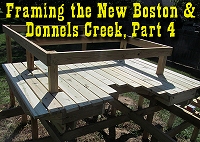 Proceed to "Framing the NEW New Boston and Donnels Creek RR, Part 4" -
With the frame for the top layer finished, I added the 2"x6" decking, leaving some extra length where I thought I might need to make further adjustment. Then I set out a loop of track to test clearances and the placement of the bridge and waterfall weir.
Proceed to "Framing the NEW New Boston and Donnels Creek RR, Part 4" -
With the frame for the top layer finished, I added the 2"x6" decking, leaving some extra length where I thought I might need to make further adjustment. Then I set out a loop of track to test clearances and the placement of the bridge and waterfall weir.
Click on the photo to see our status as of September 26, 2017
 Return to "Framing the NEW New Boston and Donnels Creek RR, Part 2" -
Once I had the overall frame relatively solid, I hooked up the underground power lines to two GFI plugs that should be in easy reach once everything is finished. I also decided to frame out the top railroad layer while I could still access the center of the railroad easily. Because I was running out of vertical space, I reconfigured that layer. Then after I got the "core" pieces on, I changed my plan again. But the whole thing is getting easier and easier to visualize, and is getting closer to complete with every board I cut and fasten on.
Return to "Framing the NEW New Boston and Donnels Creek RR, Part 2" -
Once I had the overall frame relatively solid, I hooked up the underground power lines to two GFI plugs that should be in easy reach once everything is finished. I also decided to frame out the top railroad layer while I could still access the center of the railroad easily. Because I was running out of vertical space, I reconfigured that layer. Then after I got the "core" pieces on, I changed my plan again. But the whole thing is getting easier and easier to visualize, and is getting closer to complete with every board I cut and fasten on.
Click on the photo to see our status as of September 7, 2017
 Return to "Framing the NEW New Boston and Donnels Creek RR, Part 1" -
Once I started dropping posts in the holes and screwing things together, I didn't want to stop before I had the basic frame built (for one thing, the wood warps less once it's fastened in place). Now the folks driving down the street past our house (we're on a corner lot) probably wonder if I'm building an elaborate chicken coop, but that's fine with me. I still need to make a few more lumber runs and do a lot more cutting and sawing, but having the basic frame in place should make the next bits a lot easier.
Return to "Framing the NEW New Boston and Donnels Creek RR, Part 1" -
Once I started dropping posts in the holes and screwing things together, I didn't want to stop before I had the basic frame built (for one thing, the wood warps less once it's fastened in place). Now the folks driving down the street past our house (we're on a corner lot) probably wonder if I'm building an elaborate chicken coop, but that's fine with me. I still need to make a few more lumber runs and do a lot more cutting and sawing, but having the basic frame in place should make the next bits a lot easier.
Click on the photo to see our status as of August 10, 2017
 Return to "Breaking Ground on the NEW New Boston and Donnels Creek" -
Okay, in case you wondered if we'd ever get started on the thing, we broke ground in July, using a manual post-hole digger. Well two manual post-hole diggers. But by the end of this article, we're ready for the posts to start going in.
Return to "Breaking Ground on the NEW New Boston and Donnels Creek" -
Okay, in case you wondered if we'd ever get started on the thing, we broke ground in July, using a manual post-hole digger. Well two manual post-hole diggers. But by the end of this article, we're ready for the posts to start going in.
Click on the photo to see our status as of the end of July, 2017
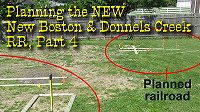 Return to "Planning the NEW New Boston and Donnels Creek, Part 4" -
Well, the rented post-hole digger fell through, so we dug our vegetable garden with a manual post-hole digger (the scissors kind). In addition, I stake out where the railroad was going to be. Twice. And tweaked the plans again. Sorry about the redo's, but sometimes just walking around the yard trying to visualize things makes me reconsider something that seemed "settled" only a few days before.
Return to "Planning the NEW New Boston and Donnels Creek, Part 4" -
Well, the rented post-hole digger fell through, so we dug our vegetable garden with a manual post-hole digger (the scissors kind). In addition, I stake out where the railroad was going to be. Twice. And tweaked the plans again. Sorry about the redo's, but sometimes just walking around the yard trying to visualize things makes me reconsider something that seemed "settled" only a few days before.
Click on the photo to see what we were considering as of late May, 2017
 Return to "Planning the NEW New Boston and Donnels Creek, Part 3" -
We have still not broken ground. In part because we plan to rent a post-hole digger and dig the post holes for our raised vegetable garden and the first phase of the garden railroad at the same time, and we don't have enough lumber on hand yet. (If we didn't break it down into multiple trips, we'd be blowing out the shocks on our minivan.) In the meantime, we used a line level to see if the slope of the back yard was as bad as we thought it was (it's worse), and we did other site preparation, including planting a whole bunch of spruce tree seedlings to eventually give us some privacy in our side and back yard. Plus, I'm still wavering a little on the "where-to-start-first" issue.
Return to "Planning the NEW New Boston and Donnels Creek, Part 3" -
We have still not broken ground. In part because we plan to rent a post-hole digger and dig the post holes for our raised vegetable garden and the first phase of the garden railroad at the same time, and we don't have enough lumber on hand yet. (If we didn't break it down into multiple trips, we'd be blowing out the shocks on our minivan.) In the meantime, we used a line level to see if the slope of the back yard was as bad as we thought it was (it's worse), and we did other site preparation, including planting a whole bunch of spruce tree seedlings to eventually give us some privacy in our side and back yard. Plus, I'm still wavering a little on the "where-to-start-first" issue.
Click on the photo to see what we were considering as of late April, 2017
 Return to "Planning the NEW New Boston and Donnels Creek, Part 2" -
More plans. We've moved on from the 2"x6" roadbed-on-posts to a sort of "train-table-outside" plan. Our goals include low-maintenance, high interest, and high reliability. We're also trying to get around having a thousand dollars' worth of dirt hauled into the back yard. If you want to get some idea of what our planning process looks like, reading these through in sequence may help. Or it may drive you crazy.
Return to "Planning the NEW New Boston and Donnels Creek, Part 2" -
More plans. We've moved on from the 2"x6" roadbed-on-posts to a sort of "train-table-outside" plan. Our goals include low-maintenance, high interest, and high reliability. We're also trying to get around having a thousand dollars' worth of dirt hauled into the back yard. If you want to get some idea of what our planning process looks like, reading these through in sequence may help. Or it may drive you crazy.
Click on the photo to see what we were considering in early April, 2017
 Return to "Planning the NEW New Boston and Donnels Creek, Part 1" -
If you're subscribed to our newsletter, you know that we moved just after Thanksgiving in 2016, leaving behind most of the track, a few of the bird feeders, and one Bachmann train set for the new owners. We also left behind a high-maintenance garden that we do not intend to replicate at the new place. This is the first chapter of a new chapter in our lives, which we hope will include a lot of "lessons learned." But first, some serious landscaping had to take place.
Return to "Planning the NEW New Boston and Donnels Creek, Part 1" -
If you're subscribed to our newsletter, you know that we moved just after Thanksgiving in 2016, leaving behind most of the track, a few of the bird feeders, and one Bachmann train set for the new owners. We also left behind a high-maintenance garden that we do not intend to replicate at the new place. This is the first chapter of a new chapter in our lives, which we hope will include a lot of "lessons learned." But first, some serious landscaping had to take place.
Click on the photo to see what we were considering in March, 2017
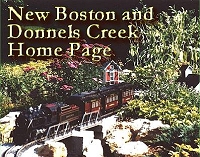 Return to the New Boston and Donnels Creek RR Page - This is the page describing Paul Race's progress and frequent rework on his own garden railroad, started on a shoe-string budget in 1998, later expanded, and later refurbished several times as issues arose. Issues that Paul hopes to avoid by building the next iteration above ground.
Return to the New Boston and Donnels Creek RR Page - This is the page describing Paul Race's progress and frequent rework on his own garden railroad, started on a shoe-string budget in 1998, later expanded, and later refurbished several times as issues arose. Issues that Paul hopes to avoid by building the next iteration above ground.
 Return to Family Garden Trains' Home Page - The home page with links to all the other stuff, including design guidelines, construction techiques, structure tips, free graphics, and more.
Return to Family Garden Trains' Home Page - The home page with links to all the other stuff, including design guidelines, construction techiques, structure tips, free graphics, and more.




Note: Family Garden Trains?, Garden Train Store?, Big Christmas Trains?, BIG Indoor Trains?, and BIG Train Store? are trademarks of
Breakthrough Communications (www.btcomm.com). All information, data, text, and illustrations on this web site are
Copyright (c) 1999, 2000, 2001, 2002, 2003, 2004, 2005, 2006, 2007, 2008, 2009, 2010, 2011, 2012, 2013, 2014, 2015, 2016, 2017 by
Paul D. Race. Reuse or republication without prior written permission is specifically
forbidden.
Family Garden Trains is a participant in the Amazon Services LLC Associates Program,
an affiliate advertising program designed to provide a means for sites to earn advertising
fees by advertising and linking to amazon.com.
For more information, please contact us
 |  |
| Visit related pages and affiliated sites: | |||||
| - Trains and Hobbies - | |||||
 |  |
 |
 |
 |  |
 |

|

|  |
 |

|
| - Christmas Memories and Collectibles - | |||||
 |

|
 |

|
 |

|
| - Family Activities and Crafts - | |||||
 |

|

|

|

|

|
| - Music - | |||||

|
 |
 |

|

|

|

|

|

|

|

|

|

|

|

|

|

|

|